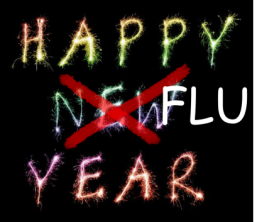It’s That Time of Year!

‘Tis the season! Those pesky pathogens love the colder weather and seem to come out in force in the fall and winter.
Influenza, norovirus, colds, and enterovirus…..some are more difficult to kill than others, but they are all spread in a similar way. These germs can make you feel miserable, and under the right conditions, can quickly move from person to person, even causing outbreaks or epidemics!
Are you prepared to battle the winter season bugs?
When the colder weather hits, many of us tend to spend more time indoors. Common colds, norovirus, and influenza are all caused by viruses which can live on surfaces for hours or even days. Those who are infected can spread these unfriendly critters, through coughing, sneezing or other body secretions. These germs can either land on surfaces, like door handles, elevator buttons, faucet handles and phones, and can also be moved to these surfaces by contaminated hands. Unfortunately, you can unknowingly pick them up when you open the door, use the phone, or push the elevator button and then later touch your eyes, nose or mouth.
Viruses aren’t susceptible to antibiotics, so, unfortunately, once infected with these viruses, they must run their course. Many of these viruses can make you feel quite miserable, so raising awareness of risk factors and measures people can take to protect themselves is an important way to reduce illness. Preventing infection and early recognition are critical to controlling the spread of these pathogens in public settings, including healthcare facilities. Consequently, healthcare personnel should review infection control policies and procedures with strict adherence to the standard and transmission-based precautions.
This article highlights some of the key actions to consider during the season of increased viruses.
Fundamental Elements to Prevent Transmission
Preventing transmission of influenza virus, the common cold, and other infectious agents within public settings, including healthcare facilities requires a multi-faceted approach. The core prevention strategies include:
- Vaccination for the virus if it is available
- Frequent and thorough hand hygiene
- Use of hygiene/cough etiquette
- Limit risk of exposure
- Cleaning and disinfection of touch surfaces
- Training and education
- Vaccination – Most common viruses don’t have a vaccine to help in prevention, but if a vaccine is available, such as the seasonal influenza vaccine, make sure you get it! Annual vaccination is the most important measure to prevent seasonal influenza. Achieving high influenza vaccination rates in our communities, and among healthcare personnel and patients, is a critical step in preventing transmission of influenza in the public and healthcare settings.
- Wash hands often
Wash hands with soap and water for at least 20 seconds, and help young children and patients do the same. If soap and water are not available, use an alcohol-based hand sanitizer. Viruses can be picked up from contaminated surfaces and transferred to your eyes, nose or mouth, increasing your risk of illness. Regular hand washing can help protect you from getting sick. It is also important that you wash your hands after coughing, sneezing or blowing your nose to prevent the spread of germs to surfaces. It is important to note that if hands are visibly soiled, they should be cleaned with soap and water to remove any contamination.
- Avoid touching your eyes, nose, and mouth with unwashed hands
Avoid touching your eyes, nose and mouth with contaminated hands, as these are the most common entry points of these seasonal viruses.
- Use respiratory hygiene/cough etiquette
Move away from others before coughing or sneezing. Cough or sneeze into a tissue, or your upper shirt sleeve, completely covering your nose and mouth. Be sure to throw away used tissues, and wash or sanitize your hands after coughing or sneezing.
- Take Steps to Minimize Potential Exposure
Infected people can spread viruses through close contact with others. Avoid close contact with others such as hugging, kissing or shaking hands if you are sick or they appear to be sick. Those who are sick should stay home, so they don’t infect others.
During the care of any patient, all healthcare personnel in every healthcare setting should adhere to standard precautions, which are the foundation to preventing the transmission of infection agents. As part of standard precautions, healthcare personnel should perform hand hygiene frequently, including before and, after all, patient contact, contact with potential infectious material, and before putting on and after removing gloves. If contact with infectious materials, blood or other body fluids is anticipated, gloves and gowns should also be worn, and then removed before leaving the room or before having contact with other patients.
It is important wear appropriate personal protective equipment when treating patients and to ensure contagious patients with these seasonal illnesses are placed on droplet precautions, isolating them from other susceptible patients. It is also important to limit infectious patient’s movement in the facility and visitors when they are in isolation, so they don’t infect others.
Healthcare personnel who develop illness and symptoms should be instructed not to report to work, or if at work, to stop patient-care activities, and don a face mask, while infectious. They should consider staying home at least 24 hours after any fever is present. In the presence of norovirus, workers should stay home until 48 hours after symptoms cease.
- Frequently clean and disinfect surfaces
Since these seasonal viruses can live on surfaces for extended periods of time, it is critical to ensure that touch surfaces are frequently cleaned and disinfected to reduce the risk that they can contaminate the hands of others or be further moved around the facility.
Standard daily cleaning and disinfection of these touch surfaces, such as door handles, telephones, faucet handles, bed rails and tables, is recommended, but in outbreak situations, the frequency may need to be increased to two or more times per day, and anytime a surface is visibly soiled. Shared items, such as toys, will also need to be cleaned more frequently.
To ensure you are using a disinfectant that it is effective, you will want to ensure that it is either EPA- or Health Canada-registered against the key pathogens of concern, such as influenza, rhinovirus, and norovirus, since these winter viruses are most likely to cause illness, absenteeism and outbreaks in the winter months. It is also important to ensure procedural compliance. Disinfectants need to stay wet on a surface for a specified period of time to be effective against pathogens. To make compliance easier, a facility should consider a disinfectant that stays wet for the required contact time, is easy to use, and is safe and pleasant for use with patients and staff.
Detailed information on environmental cleaning in healthcare settings can be found in Outbreak Prevention kits (SDFHC.com). These provide recommended products and procedures for patient care areas that are safe for staff, patients and surfaces.
- Train and Educate Personnel
Healthcare and facility managers should ensure that all personnel receive ongoing and seasonal education and training on preventing transmission of infectious agents, including norovirus, the common cold and influenza. This training will provide them with reminders on how to protect themselves and their family members.
In the healthcare setting, this training should be more intensive, and include training on how to identify the signs, symptoms, and risk factors, and include training on precautions and personal protective equipment.
Manufacturers may also be able to provide a series of training tools from outbreak prevention toolkits, to help in selecting the right products, cleaning tools and procedures.
Summary
The season is here, and none of us wants to get sick! By following the steps outlined, you will be able to increase awareness of how these nasty germs spread, and what can be done to reduce the risk of infection.

